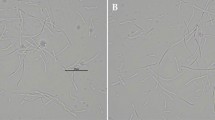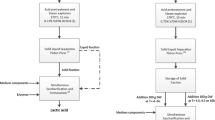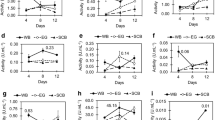Abstract
Sweet sorghum is a bioenergy crop that produces large amounts of soluble sugars in its stems (3–7 Mg ha−1) and generates significant amounts of bagasse (15–20 Mg ha−1) as a lignocellulosic feedstock. These sugars can be fermented not only to biofuels but also to bio-based chemicals. The market potential of the latter may be higher given the current prices of petroleum and natural gas. The yield and rate of production of optically pure d-(−)- and l-(+)-lactic acid as precursors for the biodegradable plastic polylactide was optimized for two thermotolerant Bacillus coagulans strains. Strain 36D1 fermented the sugars in unsterilized sweet sorghum juice at 50 °C to l-(+)-lactic acid (∼150 g L−1; productivity, 7.2 g L−1 h−1). B. coagulans strain QZ19-2 was used to ferment sorghum juice to d-(−)-lactic acid (∼125 g L−1; productivity, 5 g L−1 h−1). Carbohydrates in the sorghum bagasse were also fermented after pretreatment with 0.5 % phosphoric acid at 190 °C for 5 min. Simultaneous saccharification and co-fermentation of all the sugars (SScF) by B. coagulans resulted in a conversion of 80 % of available carbohydrates to optically pure lactic acid depending on the B. coagulans strain used as the microbial biocatalyst. Liquefaction of pretreated bagasse with cellulases before SScF (L + SScF) increased the productivity of lactic acid. These results show that B. coagulans is an effective biocatalyst for fermentation of all the sugars present in sweet sorghum juice and bagasse to optically pure lactic acid at high titer and productivity as feedstock for bio-based plastics.






Similar content being viewed by others
References
Chakravorty U, Hubert M-H, Nostbakken L (2009) Fuel versus food. Ann Rev Resour Econ 1:645–663
Rosegrant MW, Msangi S (2014) Consensus and contention in the food-versus-fuel debate. Ann Rev Environ Resour 39:18.11–18.24
Klein-Marcuschamer D, Oleskowicz-Popiel P, Simmons BA, Blanch HW (2012) The challenge of enzyme cost in the production of lignocellulosic biofuels. Biotechnol Bioeng 109:1083–1087
Ten E, Vermerris W (2013) Functionalized polymers from lignocellulosic biomass: state of the art. Polymers 5:600–642
GrandViewResearch (2014) Lactic acid and poly lactic acid (PLA) market analysis by application (packaging, agriculture, transport, electronics, textiles) and segment forecasts to 2020. http://wwwgrandviewresearchcom/industry-analysis/lactic-acid-and-poly-lactic-acid-market
Abdel-Rahman MA, Tashiro Y, Sonomoto K (2013) Recent advances in lactic acid production by microbial fermentation processes. Biotechnol Adv 31:877–902
Auras R, Lim L, Selke SEM, Tsuji H (2010) Poly(lactic acid): synthesis, structures, properties, processing and applications. Wiley series on polymer engineering and technology. Wiley, New York
Tsuji H (2005) Poly(lactide) stereocomplexes: formation, structure, properties, degradation, and applications. Macromol Biosci 5:569–597
Tenenbaum DJ (2008) Food vs. fuel: Diversion of crops could cause more hunger. Environ Health Perspect 116:A254–A257
Wang Y, Tashiro Y, Sonomoto K (2015) Fermentative production of lactic acid from renewable materials: Recent achievements, prospects, and limits. J Biosci Bioeng 119:10–18
Regassa TH, Wortmann CS (2014) Sweet sorghum as a bioenergy crop: literature review. Biomass Bioenergy 64:348–355
Whitfield MB, Chinn MS, Veal MW (2012) Processing of materials derived from sweet sorghum for biobased products. Ind Crop Prod 37:362–375
Erickson JE, Helsel ZR, Woodard KR, Vendramini JMB, Wang Y, Sollenberger LE, Gilbert RA (2011) Planting date affects biomass and brix of sweet sorghum grown for biofuel across Florida. Agron J 103:1827–1833
Kim M, Day DF (2011) Composition of sugar cane, energy cane, and sweet sorghum suitable for ethanol production at Louisiana sugar mills. J Ind Microbiol Biotechnol 38:803–807
Venuto B, Kindiger B (2008) Forage and biomass feedstock production from hybrid forage sorghum and sorghum-sudan grass hybrids. Grassland Sci 54:189–196
Vermerris W, Erickson J, Wright D, Newman Y, Rainbolt C (2011) Production of biofuel crops in Florida: sweet sorghum. University of Florida
Cao W, Liu R (2013) Screening and optimization of trce elements supplement in sweet sorghum juice for ethanol production. Biomass Bioenergy 50:45–51
Liu Q, Wang S, Zhi JF, Ming H, Teng D (2013) Efficient production of lactic acid from sweet sorghum juice by a newly isolated Lactobacillus salivarius CGMCC 7.75. Indian J Microbiol 53:332–336
Yadav AK, Bipinraj NK, Chaudhari AB, Kothari RM (2011) Production of L(+)lactic acid from sweet sorghum, date palm, and golden syrup as alternative carbon sources. Starch/Starke 63:632–636
Yu J, Zhang T, Zhong J, Zhang X, Tan T (2012) Biorefinery of sweet sorghum stem. Biotech Adv 30:811–816
Cai D, Zhang T, Zheng J, Chang Z, Wang Z, Qin PY, Tan TW (2013) Biobutanol from sweet sorghum bagasse hydrolysate by a hybrid pervaporation process. Bioresour Technol 145:97–102
Patel MA, Ou M, Ingram LO, Shanmugam KT (2005) Simultaneous saccharification and co-fermentation of crystalline cellulose and sugar cane bagasse hemicellulose hydrolysate to lactate by a thermotolerant acidophilic Bacillus sp. Biotech Prog 21:1453–1460
Energy-EERE U-Do (2015) Multiyear program Plan March 2015 update. http://www.energy.gov/sites/prod/files/2015/03/f20/mypp_beto_march2015.pdf
Abe S, Takagi M (1991) Simultaneous saccharification and fermentation of cellulose to lactic acid. Biotech Bioeng 37:93–96
Patel MA, Ou MS, Harbrucker R, Aldrich HC, Buszko ML, Ingram LO, Shanmugam KT (2006) Isolation and characterization of acid-tolerant, thermophilic bacteria for effective fermentation of biomass-derived sugars to lactic acid. Appl Environ Microbiol 72:3228–3235
Ou MS, Mohammed N, Ingram LO, Shanmugam KT (2009) Thermophilic Bacillus coagulans requires less cellulases for simultaneous saccharification and fermentation of cellulose to products than mesophilic microbial biocatalysts. Appl Biochem Biotechnol 155:379–385
Abdel-Banat BMA, Hoshida H, Ano A, Nonklang S, Akada R (2010) High-temperature fermentation: how can processs for ethanol production at high temperatures become superior to the traditional process using mesophilic yeast? Appl Microbiol Biotechnol 85:861–867
Wang Q, Ingram LO, Shanmugam KT (2011) Evolution of D-lactate dehydrogenase activity from glycerol dehydrogenase and its utility for D-lactate production from lignocellulose. Proc Natl Acad Sci U S A 108:18920–18925
Geddes CC, Mullinnix MT, Nieves IU, Peterson JJ, Hoffman RW, York SW, Yomano LP, Miller EN, Shanmugam KT, Ingram LO (2011) Simplified process for ethanol production from sugarcane bagasse using hydrolysate-resistant Escherichia coli strain MM160. Bioresour Technol 102:2702–2711
Underwood SA, Buszko ML, Shanmugam KT, Ingram LO (2002) Flux through citrate synthase limits the growth of ethanologenic Escherichia coli KO11 during xylose fermentation. Appl Environ Microbiol 68:1071–1081
Garrigues C, Loubiere P, Lindley ND, Cocaign-Bousquet M (1997) Control of the shift from homolactic acid to mixed-acid fermentation in Lactococcus lactis: predominant role of the NADH/NAD+ ratio. J Bacteriol 179:5282–5287
Hasona A, Kim Y, Healy FG, Ingram LO, Shanmugam KT (2004) Pyruvate formate lyase and acetate kinase are essential for anaerobic growth of Escherichia coli on xylose. J Bacteriol 186:7593–7600
Melchiorsen CR, Jokumsen KV, Villadsen J, Israelsen H, Arnau J (2002) The level of pyruvate-formate lyase controls the shift from homolactic to mixed-acid product formation in Lactococcus lactis. Appl Microbiol Biotechnol 58:338–344
Geddes CC, Mullinnix MT, Nieves IU, Hoffman RW, Sagues WJ, York SW, Shanmugam KT, Erickson JE, Vermerris WE, Ingram LO (2013) Seed train development for the fermentation of bagasse from sweet sorghum and sugarcane using a simplified fermentation process. Bioresour Technol 128:716–724
Geddes CC, Peterson JJ, Mullinnix MT, Svoronos SA, Shanmugam KT, Ingram LO (2010) Optimizing cellulase usage for improved mixing and rheological properties of acid-pretreated sugarcane bagasse. Bioresour Technol 101:9128–9136
Martinez A, Rodriguez ME, Wells ML, York SW, Preston JF, Ingram LO (2001) Detoxification of dilute acid hydrolysates of lignocellulose with lime. Biotechnol Prog 17:287–293
Miller EN, Jarboe LR, Yomano LP, York SW, Shanmugam KT, Ingram LO (2009) Silencing of NADPH-dependent oxidoreductase genes (yqhD and dkgA) in furfural-resistant ethanologenic Escherichia coli. Appl Environ Microbiol 75:4315–4323
Wang X, Yomano LP, Lee JY, York SW, Zheng H, Mullinnix MT, Shanmugam KT, Ingram LO (2013) Engineering furfural tolerance in Escherichia coli improves the fermentation of lignocellulosic sugars into renewable chemicals. Proc Natl Acad Sci U S A 110:4021–4026
Acknowledgments
This work was supported by grants from the US Department of Agriculture (USDA) (2012-67009-19596; LOI) and Biomass Research and Development Initiative Competitive Grant (2011-10006-30358) from the USDA National Institute of Food and Agriculture. This work was also supported by funding from the US Department of Energy’s Office of Energy Efficiency and Renewable Energy, Bioenergy Technologies Office, and sponsored by the US Department of Energy’s International Affairs under award number DE-PI0000031 and the Florida Department of Agriculture and Consumer Services.
Author information
Authors and Affiliations
Corresponding author
Electronic supplementary material
Below is the link to the electronic supplementary material.
ESM 1
(PPTX 77 kb)
Rights and permissions
About this article
Cite this article
Ou, M.S., Awasthi, D., Nieves, I. et al. Sweet Sorghum Juice and Bagasse as Feedstocks for the Production of Optically Pure Lactic Acid by Native and Engineered Bacillus coagulans Strains. Bioenerg. Res. 9, 123–131 (2016). https://doi.org/10.1007/s12155-015-9670-6
Published:
Issue Date:
DOI: https://doi.org/10.1007/s12155-015-9670-6




